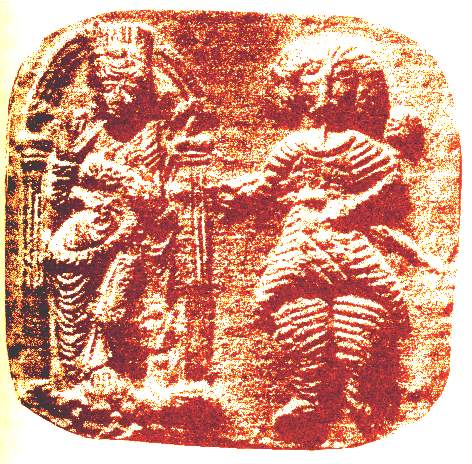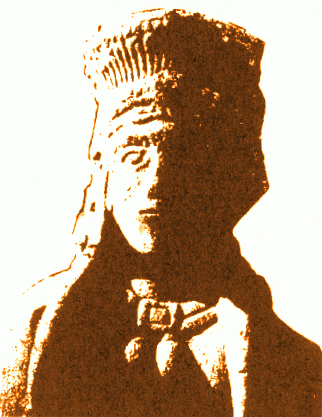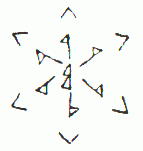  WORDTIMES
29 WORDTIMES
29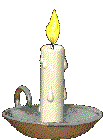
OUR SENSATIONAL ANCEINT MEMORIES |
|
|
There was a time when the preservation of these memories was a matter of life and death. Our thousand year old ancient written records have been preserved on this slate tablet. Besides the runic characters used at the time there is a sample text written with these in which the greatly controversial names of our forefathers and foremothers can be read. The photos were made by Tamás Szentgyörgyváry and were first published in Sumerologist professor Veronika Marton's book entitled "Somogy rovas tablet and the taltos stones." I recommend the book to all of our readers who are interested in our ancient history. The large size tablet is very important in the history of Magyar-Hun literacy because it highlights the fact that our nation's history and cultural relics go back much longer than they have tried to have us believe for the past thousand years. |
|
 |
The vertical
line in the middle reads:
|
|
Anahita and a Parthian. |
Matriarch Anahita |
|
Here we shall rely on Veronika
Marton's decipherment who patiently analyzed the text which was fragmented
here and there. The top line should be read from right to left, as
indicated by the letters? direction. The ancient Egyptian hieroglyphics
are read in a similar way. The figures face the direction in which the
text should be interpreted. We use this in One of the most interesting one out
of those is the runic word ATYA (FATHER). JA... PASA JŐ BE IDE, HONN NE VÁRJ, SZOLÁK ÉNE (pasa come hither within, linger not at home/do not wait upon me oh, my homeland, I have spoken) The second row to the left can be read from right to
left, and here the M phonemes are listed. am, m, m, m, im, m, um, em,
om, um. Am can be read from the left. (R in the initial and final positions are signified by different characters) |
|
|
|
The interesting thing is that to the right of the writing there is a complex six-symmetry merged runic sign, which gives the word SAMAS if we read it along any diagonal line. This is an excellent proof of our Sumerian ancestry. There is a character M merged together with character A in the middle. This is interesting, because one of the six is always missing which comes form the principle of operation of the space quantum. An allusion to this could be the fact that in our runic writing system an upside-down S character means number 5. SAMAS is known from Sumerian mythology, he is the Sun god. Six-symmetry is the sign of the space quantum. Of the Almighty. He holds in existence everything throughout the solar system. |
|
His Egyptian name is RE or RA. Yes,
but very possibly they did not mean and know the same by the term. SA-MAS.
RA-MAS? Since the ancient Sumerian sign of MAS is a cross, an isosceles
water cross. This was a Christian sign even six thousand years ago. The
Hungarian word MAS (different/other) signifies that is not original it is
a simile. This does not, however, mean that it has been degraded.
Sumerologists translate it as half, partial but also aspure. This appears
in the pur, pure form in the Latinic languages. PU-RE. Pu denotes
emanation and RE shows who it belongs to. By the word "dio" an Italian
person understands God. Our word RA-DIO is very interesting by which an
Italian listener will unequivocally understand god Ra. The waves are
really etherical and are similar in many ways to the wave-world of the
spacesource found in the Sun. The Sun God is transcendent, and is not an
white bearded old man. |
|
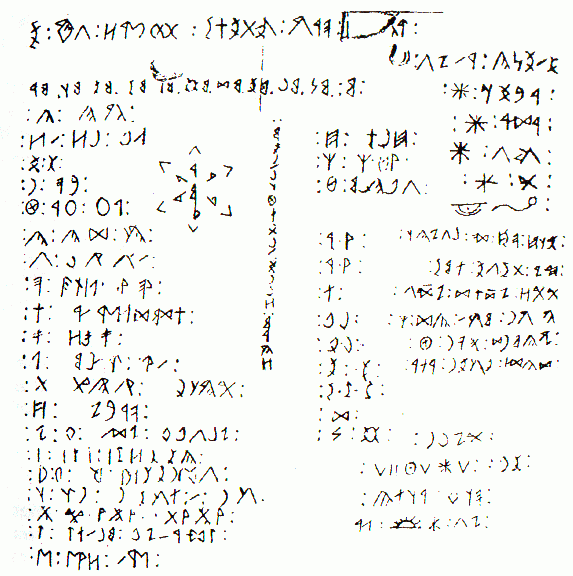
We give the negative of the picture here for easier
understanding. Well, there is a real scientific sensation behind this
since there is an |
Continuing in the third row the
consonants He, He He; Do Not PAN (NAP); Fe, AF, FA; Le, LU (UL), BOWL (SEE);
Se, OS?, SeTeR; Pe, Wendy213, FATHER; But, ARÁVSzUMUD (DUMUSVÁRA); Dumuz (Dumus
is the God of spring and rebirth in Sumerian, the founder of Duldumast
Baranya. There was a city by this name by the road to Jerusalem. (Via
Hierosolymitana (1030-1043): ad civitatem, quae vocatur Duldumast). Word
(W), RiGyOGy (remedy); , MORÁJ (JÁROM), JAR (RAJ); (ÁSALÁB), BÁLASÁ,
NOTALAB (Lake BALATON); CsE, KANACS (KHAN CSANAK drinking vessels ); Ka,
Ke, SUK (KUSH), RAMS; Sze, zSIzS (SZISZ), SzÉRNEL (LENDRSz); iNe (Nye),
eNi, ... TiNy, NyTNTENAVOS (Sovány?...?); Te, TJeNaT, NETSI (ISTEN, God),
Re NeTSe; (Accding to Plato ER was Pamphilian (Asia minor) sage whom many
identify and others confuse with Zoroaster). The phrase probably in
today's Hungarian could be translated as follows: God teaches of God. Tye,
ATYA, ATYA, ...BATYA, Ce CITROM, OKRADUC, (Cudarko Moric); Ve, VAR, RÁV
(VÁR); eZ, DÖZ ZÖD (green); sZe, ZsÁLyA; LY, MOLyOS (SOLyOM). |
|
|
|
|
ALL RIGHTS RESERVED Š 2007 UNIVERSUM UNIVERSITAS. This
publication was prepared for personal use only. |
|
